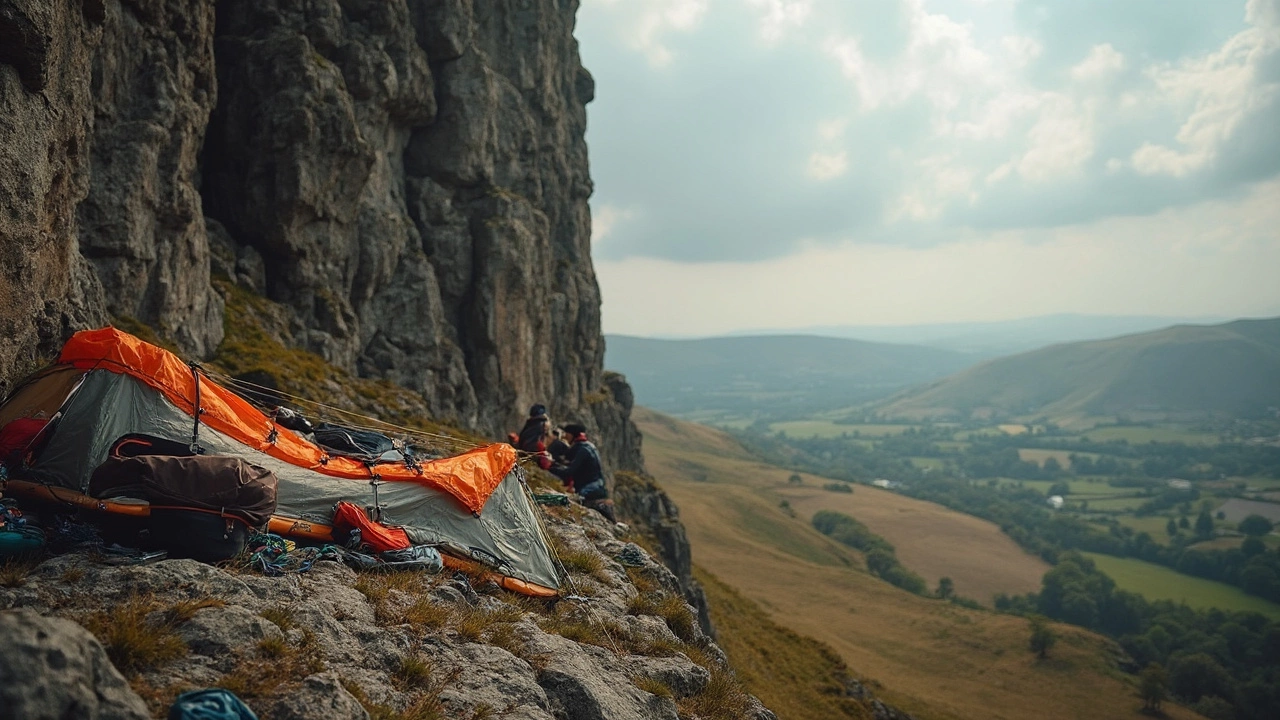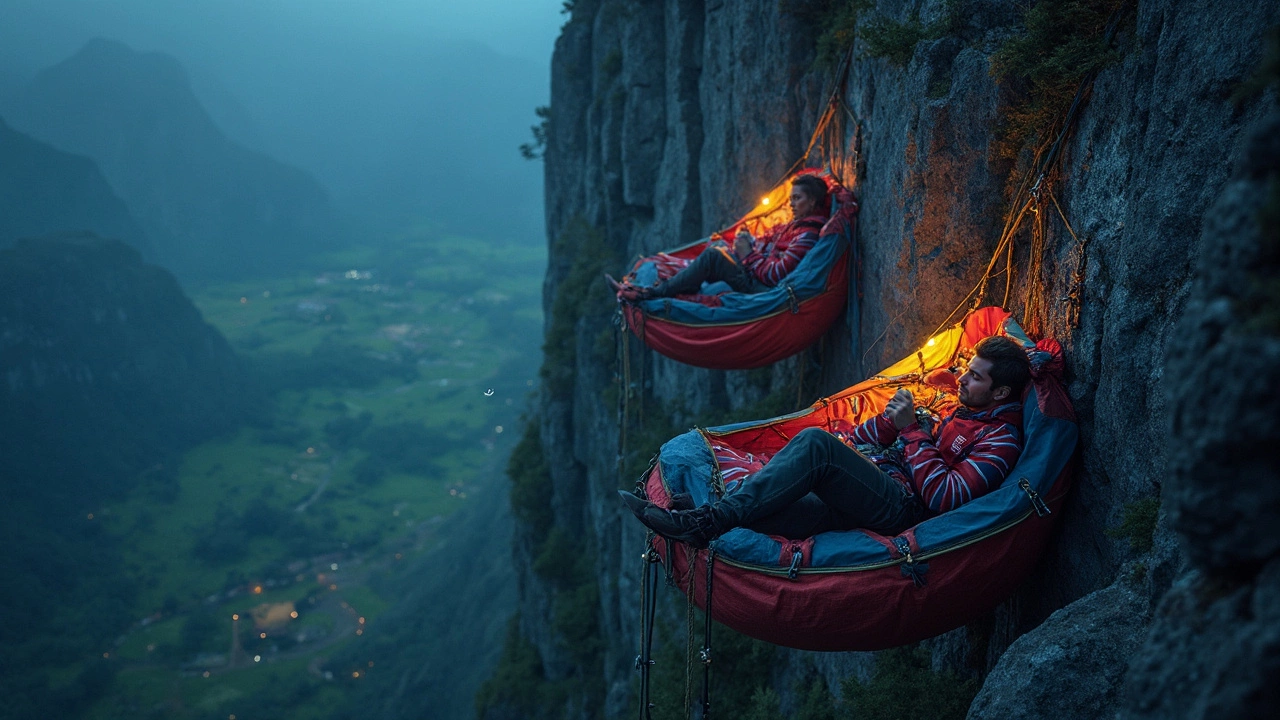Imagine rolling over in your sleep and instead of bumping into your partner in a tent, you open your eyes to a breathtaking drop—hundreds, maybe thousands, of feet of nothingness below. That’s not some nightmare. That’s vertical camping. For most of us, sleeping on the edge means getting used to someone hogging the covers. For vertical campers, it means the difference between a wild night and, well, a much wilder one. Cliff faces are their hotel rooms. Ropes, anchors, and hanging tents called portaledges, are the only things keeping them from gravity’s worst-case scenario.
What is Vertical Camping?
Vertical camping isn't about pitching a tent in some weird, slanted campsite. This is the real deal—setting up a shelter directly on the side of a cliff. Campers spend the night on special platforms called portaledges, dangling over empty air. Originally, this trick belonged almost entirely to big-wall climbers. Climbs like El Capitan in Yosemite can take several days, and there weren't exactly a string of Airbnb cabins on those granite faces. But now, vertical camping has exploded into a full-blown adventure for anyone bold enough to trust ropes, steel, and stitching. Some guides actually sell the experience to brave city folks who've never even set a tent peg.
Most portaledges are basically reinforced, fabric-covered cots with burly frames—strong enough to support two adults and all their gear. They hang from a single anchor point, with straps and buckles for leveling everything out. Try pitching that in a regular campground! The most insane part isn’t just the sleeping arrangement. It’s the way campers learn to eat, brush their teeth, change clothes, and sometimes even go to the bathroom—all while suspended in midair. Above it all, a rainfly or extra tarp can shield them from the weather. The height record for portaledge camping tops out around 16,000 feet, on the Trango Towers in Pakistan. That's almost three miles above sea level!
Not everyone gets into vertical camping for a summit. Some people are hooked on the raw mix of exposure and beauty. Sunrise over sheer faces. Eagles gliding below. That heart-jolting sense that the world is way, way bigger than your tiny human frame. Others come for the ultimate story to tell at a backyard BBQ. Either way, you get a campout you’ll never, ever confuse with a night in a cabin.
How Do Campers Pull Off Vertical Nights?
It takes a ton of planning—seriously, this isn’t a hobby you jump into with a supermarket tent and good intentions. The centerpiece is the portaledge. A strong, lightweight frame made of aluminum poles (think overbuilt camping cot) creates the boundary. The bed is a canvas or nylon platform, built to carry hundreds of pounds. These things fold up small and weigh around 13–20 pounds for a two-person version, though solo versions are lighter and can go anywhere from $700 to $1400 depending on the brand. The leading models are designed to withstand gusts up to 50 mph and falling rocks the size of grapefruits. You’ve got to respect the engineering in that.
Getting everything out of your backpack while dangling from a harness is an art of its own. Climbers hone these skills on their living room floors before they trust them to a thousand-foot drop. Every movement is deliberate. Every gear check is triple-checked. The stakes are, well, pretty obvious. Knots, carabiners, anchors—all get checked for wear, tightness, and positioning. Dropping a toothbrush is just annoying. Dropping a stove or water bottle could mean heading down early.
There’s also the question of, you know, sleep. It turns out you can train your brain to rest really well on a ledge with nothing between you and terminal velocity except a bit of nylon and faith in your knots. Some climbers swear the gentle sway helps them nod off. Others stick headphones in—nature sounds optional. Either way, a sleeping bag is a must, and a sleeping pad offers a tiny slice of normal comfort. Partners tie in, so nobody rolls out in the night. For little things—water, snacks, phones—mesh pockets or hanging stuff sacks clip on, making life easier. As for, uh, necessary business—yep, campers use wag bags or small portable toilets, because nobody wants a surprise from above. Some systems are so light and ingenious, NASA stole ideas for the space station.

Why Do People Do It? Not Just for Thrill Seekers
So why bother? The most obvious answer is the thrill. But once you’ve spent a night perched high above the world, it’s about more than just adrenaline. For many, it’s about the perspective—literally and mentally. Looking down at sweeping valleys and endless sky changes something in you. Worries that felt huge back at home shrink. Kids like mine—Renly, if you’re reading this someday, yes, Dad wants to try it with you—see the world with a different kind of wonder.
It’s also a major mental reset. Notice how most folks come back from a hike with a spring in their step? Multiply that by ten after a vertical night. Scientists at Stanford once found that even short wilderness escapes reduce the brain’s “rumination” cycles. Sleeping suspended high above the ground, surrounded by nothing but cliff and stars, makes distraction impossible. There are no emails. No traffic. Just you, your partner, maybe some mountain goats, and a sky busy with satellites and shooting stars. The experience sticks for life.
For social types, vertical camping is a community thing too. It started as a “big wall” climbing hack, but now guides in places like Yosemite and the Dolomites run overnight experiences for anyone—no rope skills required. You get rigged up for the night, get a crash course in knots, and eat instant noodles above the void. Your Instagram will explode. Some even do it for charity events, with teams suspended along famous cliffs to fundraise for causes like wildlife conservation or mental health programs. Talk about hanging out for a good cause.
Tips, Warnings, and Cool Facts for Would-Be Vertical Campers
Anyone thinking about giving this a shot needs more than guts. Here are some hardcore tips straight from the vertical world:
- Vertical camping always starts with checking local regulations. Not all cliffs are fair game, and some national parks have tight rules about camping off the ground.
- Go with a pro the first time—there are guiding companies with gear, instructors, and permit know-how scattered through the US, Europe, and Asia. Don't cheap out, your life quite literally hangs in the balance.
- Test your gear in the backyard or at the local climbing gym—and pack redundancies for anchors, carabiners, and harnesses.
- Dress in layers, and expect extreme temperature shifts, especially at altitude.
- Check all connections before committing your bodyweight; one survey in 2023 showed over 75% of climbing accidents stem from user error, not gear failure.
- Sunrise and sunset are next-level from a portaledge. Bring a camera that’s easy to operate one-handed. Just don’t drop it!
- If you tend toward motion sickness, practice on swings or hammocks first.
- Hydration is king. Dehydration symptoms sneak up fast in the dry, high mountain air.
- Get used to less privacy, but also bragging rights like nothing else.
Some climbers up the ante, choosing vertical camping in remote places like Patagonia’s Fitz Roy, or Norway’s Troll Wall. Rare camps on active climbs have had to dodge rain, snow, even flocks of curious birds. There’s a story about a famous climber who woke up to find a marmot rooting through his snacks—on a ledge a thousand feet above the ground! More common is the sight of city lights glittering below during a rare “urban vertical campout” (yep, they exist, usually as promotional stunts).
Here’s a quick breakdown of what vertical campers typically face on a multi-day climb:
| Item | Weight (lbs) | Notes |
|---|---|---|
| Portaledge (2-person) | 13-20 | Main platform, collapsible aluminum frame |
| Rainfly/Weather Cover | 4-6 | Protects campers, can be noisy in the wind |
| Sleeping Bags | 3-6 each | Down preferred for weight and warmth |
| Food and Water | Depends | Dehydrated meals, 2-4L water per person per day |
| Climbing Rope | 7-10 | Core safety, can double as anchor lines |
| Anchor Systems & Carabiners | 5-7 | Redundant, heavy-duty |
| Wag Bags/Toileting System | ~1 | Absolutely required for Leave No Trace |
In short, vertical camping isn’t just about testing limits. It’s about flipping your whole idea of “getting outside” on its head. Yes, it takes cash, courage, planning, and a healthy respect for gravity. But those who give it a try walk—or rappel—away with a new understanding of what’s possible. So next time you’re grumbling about a lumpy campground, remember: for some people, ‘flat ground’ is just a state of mind.
